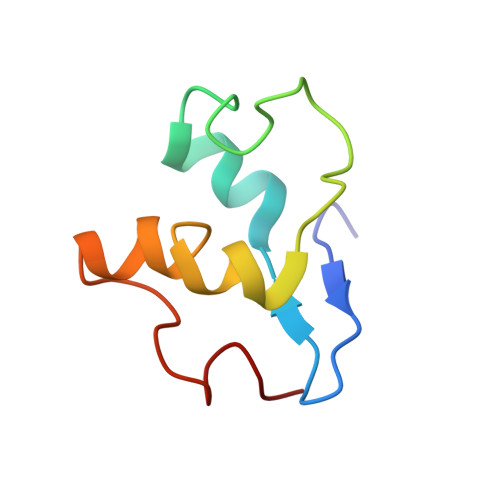Unveiling the Structural Basis That Regulates the Energy Transduction Properties within a Family of Triheme Cytochromes from Geobacter sulfurreducens.
Dantas, J.M., Simoes, T., Morgado, L., Caciones, C., Fernandes, A.P., Silva, M.A., Bruix, M., Pokkuluri, P.R., Salgueiro, C.A.(2016) J Phys Chem B 120: 10221-10233
- PubMed: 27603556
- DOI: https://doi.org/10.1021/acs.jpcb.6b07059
- Primary Citation of Related Structures:
2N91 - PubMed Abstract:
A family of triheme cytochromes from Geobacter sulfurreducens plays an important role in extracellular electron transfer. In addition to their role in electron transfer pathways, two members of this family (PpcA and PpcD) were also found to be able to couple e - /H + transfer through the redox Bohr effect observed in the physiological pH range, a feature not observed for cytochromes PpcB and PpcE. In attempting to understand the molecular control of the redox Bohr effect in this family of cytochromes, which is highly homologous both in amino acid sequence and structures, it was observed that residue 6 is a conserved leucine in PpcA and PpcD, whereas in the other two characterized members (PpcB and PpcE) the equivalent residue is a phenylalanine. To determine the role of this residue located close to the redox Bohr center, we replaced Leu 6 in PpcA with Phe and determined the redox properties of the mutant, as well as its solution structure in the fully reduced state. In contrast with the native form, the mutant PpcAL6F is not able to couple the e - /H + pathway. We carried out the reverse mutation in PpcB and PpcE (i.e., replacing Phe 6 in these two proteins by leucine) and the mutated proteins showed an increased redox Bohr effect. The results clearly establish the role of residue 6 in the control of the redox Bohr effect in this family of cytochromes, a feature that could enable the rational design of G. sulfurreducens strains that carry mutant cytochromes with an optimal redox Bohr effect that would be suitable for various biotechnological applications.
Organizational Affiliation:
UCIBIO-Requimte, Departamento de Química, Faculdade de Ciências e Tecnologia, Universidade NOVA de Lisboa , Campus Caparica, 2829-516 Caparica, Portugal.















